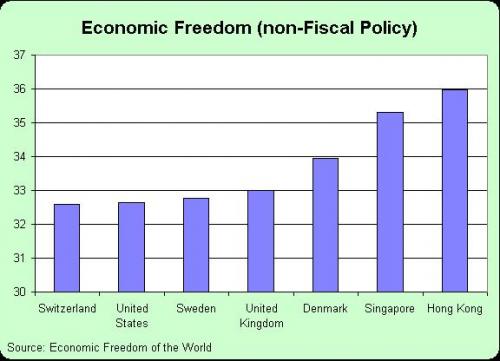Johnny Munkhammar is a member of the Swedish Parliament and a committed supporter of economic liberalization. He has a column in the Wall Street Journal Europe that does a great job of explaining how Sweden became rich when it was a small-government, pro-market nation. He then notes that his country veered off track in the 1970s and 1980s, but is now heading back in the right direction. I’ll have more analysis below these excerpts, but it is especially impressive that Sweden is ahead of America on key reforms such as Social Security personal accounts and school choice.
…Sweden is not socialist. According to the World Values Survey and other similar studies, Sweden combines one of the highest degrees of individualism in the world, solid trust in well-functioning institutions, and a high degree of social cohesion. Among the 160 countries studied in the Index of Economic Freedom, Sweden ranks 21st, and is one of the few countries that increased its economic freedoms during the financial crisis.
…Sweden wasn’t always so free. But Sweden’s socialism lasted only for a couple of decades, roughly during the 1970s and 1980s. And as it happens, these decades mark the only break in the modern Swedish success story.
…The Swedish tax burden was lower than the European average throughout these successful 60 years, and lower even than in the U.S. Only in 1950 did Sweden’s tax burden rise to 20% of GDP, though that remained comparatively low.
…The 1970s were a decade of radical government intervention in society and in markets, during which Sweden doubled its overall tax burden, socialized a slew of industries, re-regulated its markets, expanded its public systems, and shuttered its borders. In 1970, Sweden had the world’s fourth-highest GDP per capita. By 1990, it had fallen 13 positions. In those 20 years, real wages in Sweden increased by only one percentage point.
…By the late 1980s, though, Sweden had started de-regulating its markets once again, decreased its marginal tax rates, and opted for a sound-money, low-inflation policy. In the early 1990s, the pace quickened, and most markets except for labor and housing were liberalized. The state sold its shares in a number of companies, granted independence to its central bank, and introduced school vouchers that improved choice and competition in education. Stockholm slashed public pensions and introduced private retirement schemes, keeping the system demographically sustainable.
These decisive economic liberalizations, and not socialism, are what laid the foundations for Sweden’s success over the last 15 years. …Today, the state’s total tax take comes to 45% of GDP, from 56% ten years ago.
Meanwhile, unemployment benefits, sick leave and early retirement plans have all been streamlined to encourage work. The number of people receiving such welfare—which soared during the socialist decades—has fallen by 150,000 since 2006, a main reason for Sweden’s remarkably sound public finances.
Sweden still has a public sector that is far too big, but the damage caused by bloated government is at least partially offset by very good policy in other areas. Sweden is actually slightly more free market than the United States on non-fiscal measures in the Economic Freedom of the World index. Here’s a chart comparing Sweden and the United States. But I also included a few other nations for purposes of comparison. You can see Switzerland, the U.S., Sweden, and the United Kingdom all have similar scores for economic freedom if the burden of taxation and government spending is removed from the mix. But things change dramatically when taxes and spending are added to the formula. Switzerland is ranked 4th overall because of a decent fiscal system, ahead of the United States (6th) and United Kingdom (10th). while Sweden falls all the way to 37th place.
Denmark gets very high marks for non-fiscal freedom, so it only drops to 14th in the overall rating because of its bloated welfare state. Hong Kong and Singapore, meanwhile, rank 1st and 2nd in the world because of strong ratings on non-fiscal factors and they also manage to limit the fiscal burden of government.
Last but not least, many of Johnny’s points are included in this Center for Freedom and Prosperity video.


